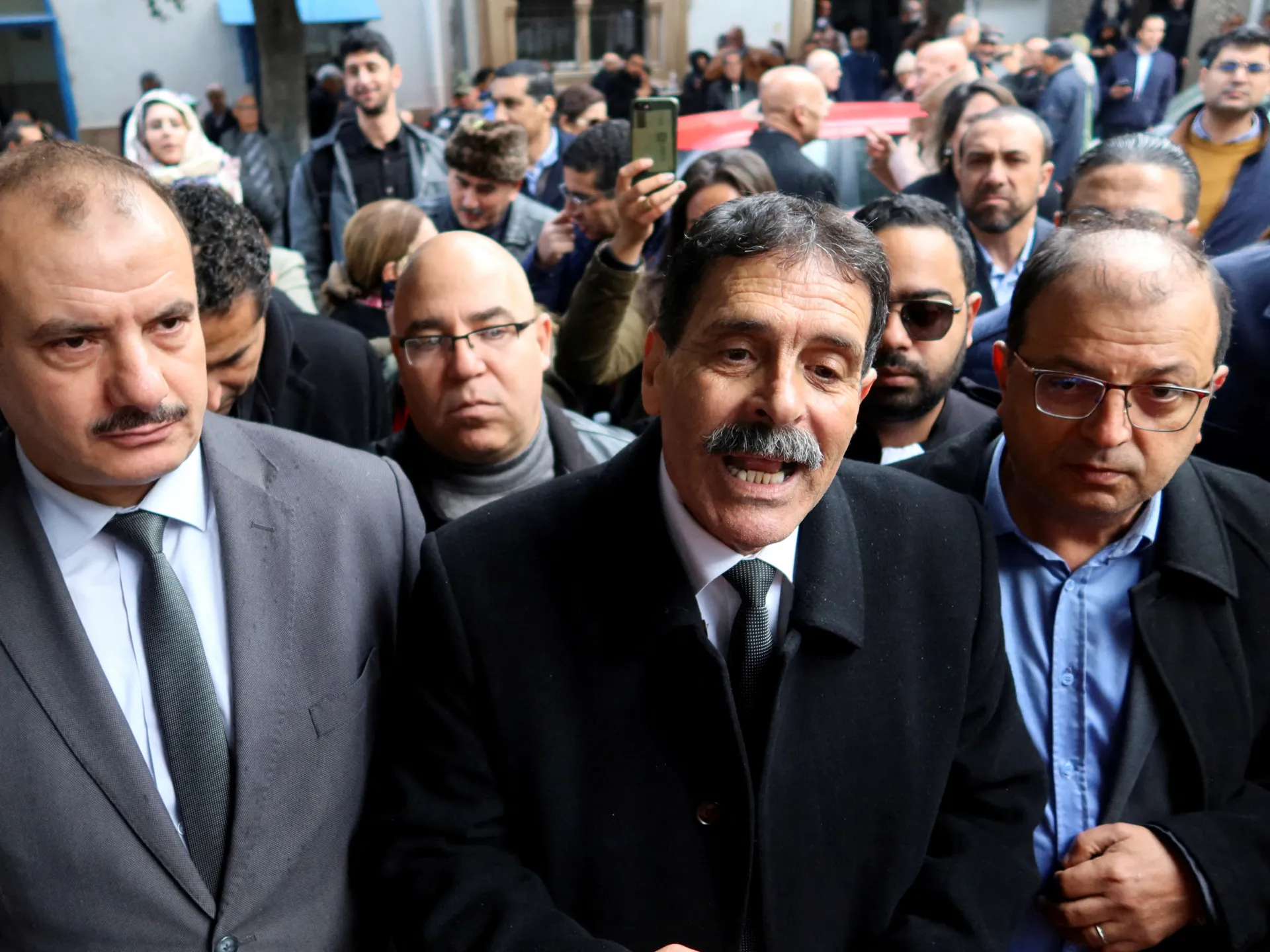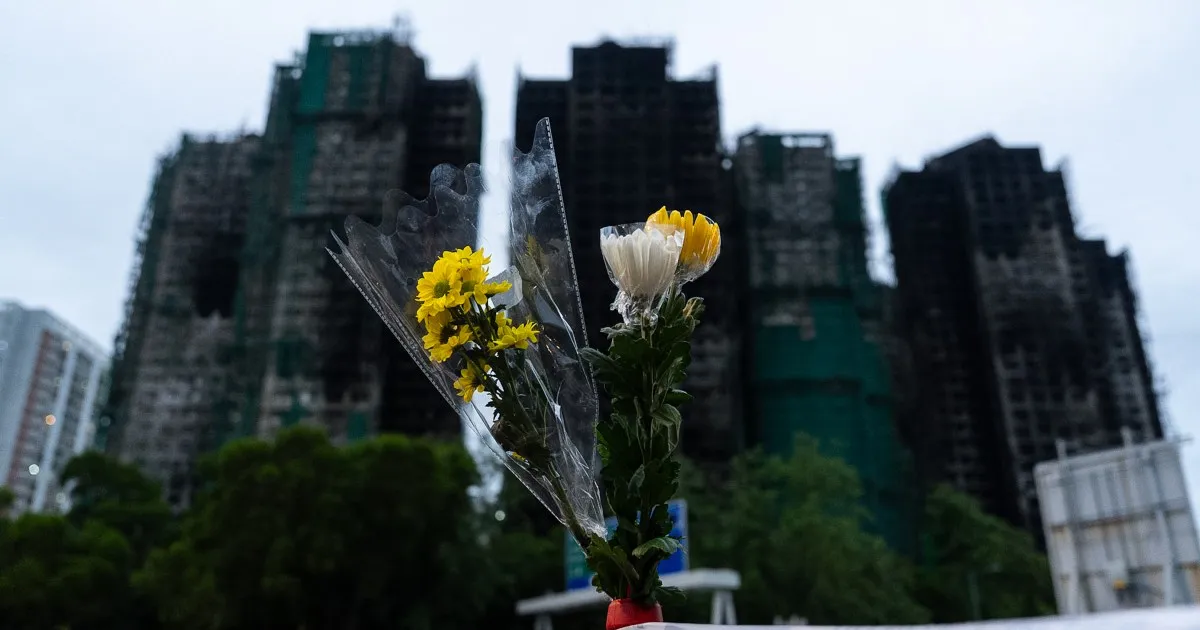Chinese authorities have arrested several activists and issued a stern warning to “anti-China and pro-chaos elements” amid criticism of the government’s response to Hong Kong’s deadliest fire in a generation.
Hong Kong’s national security police arrested three people over the weekend, state-backed and commercial media reported, as calls mounted for accountability following the city’s worst fire in nearly eight decades.
Recommended Stories
list of 4 itemsend of list
Authorities arrested ex-district Councillor Kenneth Cheung Kam-hung and an unidentified volunteer who managed supplies for survivors on Sunday, according to multiple reports, a day after the arrest of a university student on suspicion of sedition. Cheung was arrested on suspicion of “attempting to incite discord”, The Standard newspaper reported.
On Saturday, authorities arrested Miles Kwan, a 24-year-old student at the Chinese University of Hong Kong, after he created an online petition calling for greater transparency and accountability from the government, multiple reports said.
The petition included four demands, including the establishment of an independent commission of inquiry to probe the circumstances of the fire, including whether potential conflicts of interest may have contributed to the disaster.
Before it was removed from the internet on Saturday, the petition had garnered more than 10,000 supporters.
China’s national security office in Hong Kong appeared to condemn the petition before its removal, accusing activists of using “the banner of ‘petitioning the people’ to incite confrontation and tear society apart.”
Hong Kong’s Office for Safeguarding National Security also accused figures with “sinister intentions” of exploiting the fire to return the city to the “black-clad violence” that erupted during mass antigovernment protests in 2019.
On Monday, a commentary in the Beijing-backed Wen Wei Po newspaper called on the public to be vigilant against “anti-government elements” with “malicious intentions”.
“They have even gone so far as to ‘act as representatives’ to establish a so-called ‘concern group,’ put forward so-called ‘four demands,’ distribute leaflets, and launch a petition, all in an attempt to incite public unrest,” the commentary said.
“Their actions are utterly devoid of conscience and humanity.”
‘Outrageous’
The crackdown is the latest sign of the narrowing space for dissent in Hong Kong following Beijing’s sweeping overhaul of the semi-autonomous territory’s political and legal landscape in response to the 2019 demonstrations.
China has repeatedly denied that Hong Kong’s civil liberties have deteriorated, insisting that the passage of two far-reaching national security laws have ensured that residents’ rights and freedoms are “even better protected” than before.
Beijing has also argued that the legislation ensures the continuation of Hong Kong’s partial autonomy under “One Country, Two Systems,” the arrangement under which UK returned the territory to China in 1997.
Nathan Law, an activist and critic of Beijing who served in Hong Kong’s legislature, called the authorities’ actions “outrageous” and the latest example of a “highly authoritarian trend” in the former British colony.
“The goal of the government is to create a chilling effect by arresting these individuals. Any civil actions without the government’s permission are now illegal,” Law, who lives in self-exile in the UK and is wanted by Hong Kong authorities on national security charges, told Al Jazeera.
“The government worries about people congregating and initiating collective action, whether it is political or not.”
The Hong Kong Police Force did not respond to requests for comment.
Ronny Tong, a non-official member of Hong Kong’s de facto cabinet, disputed the suggestion that authorities were stifling criticism of the government’s handling of the disaster.
“If you look at the major newspapers in Hong Kong, there are very many various suggestions and… criticisms of the handling of the incident in Hong Kong, so by no means is there a general suppression of different views or criticisms of the government,” Tong told Al Jazeera.
Tong said that that while it would be inappropriate to comment on the cases of people who had yet to face the judicial process, the law allowed for “constructive” criticism of the authorities.
“One must not simply make the case of a few arrests – the circumstances of which are still unclear – to come to the conclusion that the Hong Kong government are trying to stifle views which they don’t like,” he said.
At least 151 people were killed in Wednesday’s blaze at a high-rise apartment complex in Hong Kong’s northern district of Tai Po, the worst fire in the city since at least 1948.
The scale of the disaster has prompted scrutiny of safety standards in Hong Kong’s construction industry, with authorities honing in on how the use of substandard materials in renovation works on the block may have aided the fire’s rapid spread.
Hong Kong authorities have arrested 13 people as part of their investigations into the fire, including the directors of an engineering consultant company involved in the renovations.
Commission of Inquiry
While the Hong Kong police and the city’s Independent Commission Against Corruption have launched separate investigations, the government has so far not indicated that it will establish an independent commission of inquiry.
Hong Kong authorities launched commissions of inquiry, a legacy of British rule in the territory, in response to many past disasters.
Past inquiries, which have been typically led by a judge, looked into tragedies including a 2012 ferry accident that left 39 people dead and a 1996 fire that cost 41 lives.
Kevin Yam, a former lawyer in Hong Kong, said that Beijing could not tolerate public criticism of the official response to the fire as it was concerned that “the smallest spark of dissent can snowball into something bigger”.
“Those who read George Orwell will know that phrase, ‘They who control the past control the present future, and they who control the present control the future.’ And the Communist Party of China has always been very good at that,” Yam, who is wanted by the Hong Kong authorities for alleged national security offences, told Al Jazeera.
“They see that once they silence the dissent and the criticism, and then they flood the zone with favourable stories about how they handled things, then that becomes the official record of history.”
Once known for its raucous media, vibrant civil society and political diversity, Hong Kong has dramatically curtailed the space for dissent since the 2019 protests.
Under the laws, which have been widely condemned by foreign governments and rights groups, authorities have forced the closure of critical media outlets, effectively eliminated opposition parties from the city’s legislature, and banned politically sensitive protests.
The mainland Chinese and Hong Kong governments have defended the laws as a proportionate response to the antigovernment protests, which began peacefully before descending into street battles between demonstrators and police, and other national security threats facing the territory.
In a speech marking the fifth anniversary of the 2020 law in June, Xia Baolong, Beijing’s top official for Hong Kong affairs, called the legislation a “guardian” of the city’s semi-autonomous status and stability.







